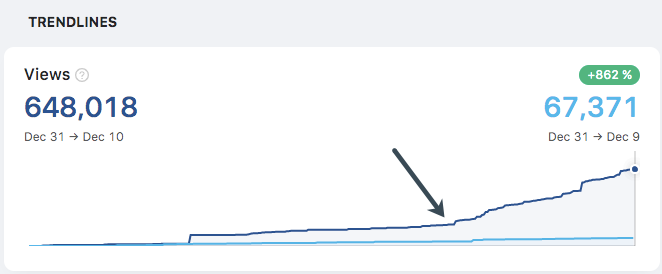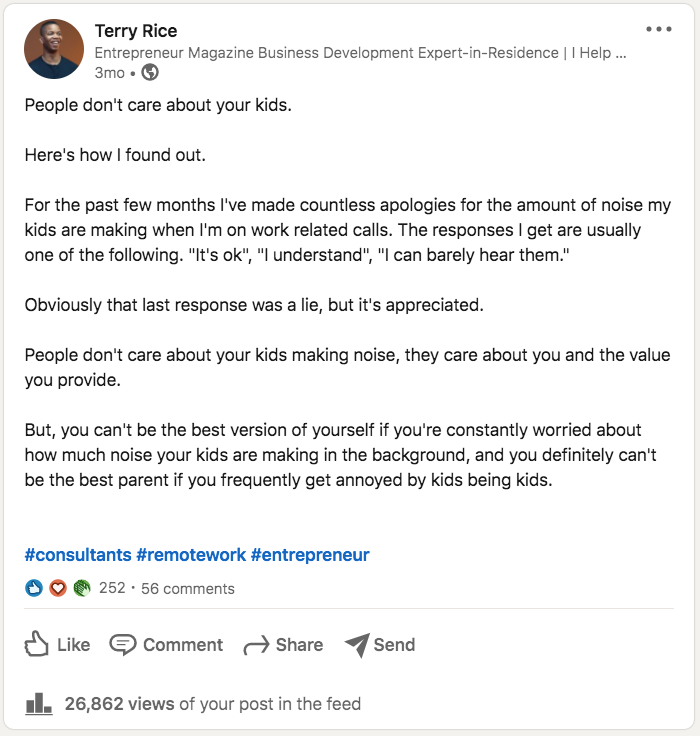I Posted On LinkedIn 90 Times in 90 Days. Here's Why You Should Too. Learn how consistently posting relevant content can grow your personal brand and revenue.
By Terry Rice Edited by Dan Bova

Want to be part of the one percent? Here's your chance.
Content on the LinkedIn feed receives about 9 billion impressions per week, but only 3 million users (out of the more than 700 million) share content on a weekly basis. This means that only about one percent of LinkedIn's 260 million monthly users share posts, and those 3 million or so users net the 9 billion impressions.
As a result -- and in contrast to Facebook, Instagram and Twitter — content posted on LinkedIn can still get visibility in the feed several days after being posted. This is because LinkedIn is a content deficient platform.
Taylor Offer, founder of Taylor Parker Agency, explains:
"A content deficient platform is a social media platform that has more people consuming the content than creating it. This means the platform needs good content to stretch further. So your content will get shown to your whole following and then some."
Related: 5 Social Media Marketing Mistakes You Need to Avoid
Beyond that, as per Digital Marketing expert Neil Patel, LinkedIn accounts for about 80% of B2B leads generated from Social Media.
Recognizing this as an opportunity to grow his personal brand and agency, Taylor honed his LinkedIn approach and grew his following to 100,000 people, consistently reaching millions with his posts. Taylor then packaged his process into an online course, The LinkedIn Playbook, which I put into action over a period of 90 days.
Although I'm still 95,000 followers short of 100,000, the impact has been undeniable.
LinkedIn data from Shield Analytics shows my total content views over the past year. (the arrow indicates when I started to post consistently) Of the nearly 650k views I received, roughly 400k (62%) came during that 90 day period.

I'll share more of my results and -- more importantly -- describe how you can take advantage of this opportunity as well.
Related: How to Create an Irresistible Offer by Surveying Your Audience on LinkedIn
Why to consistently create content
To effectively leverage LinkedIn, it's important to post on a regular basis. I'm not going to get too deep into the science behind it but you should be aware the LinkedIn algorithm has two primary goals:
- To prioritize relevant content
- To promote engagement
Algorithms rely on data to make predictions. So, if you're not posting on a regular basis, the algorithm has less data to determine whether or not your content will be relevant or engaging. In which case, another user who posts more frequently will be more predictable and a safer bet.
How to consistently create content
Great. So, how do you post consistently? I'll go into part of Taylor's process now.
Start by thinking about how you want to be perceived on the platform. But, here's where most people mess up. Since LinkedIn is a professional networking site, there's an unjustified pressure to be more buttoned-up with the content shared as compared to other platforms. Unfortunately, this is the perfect way to blend in and be boring, which goes against the goal of being relevant and engaging.
To avoid this, you'll need to establish your content pillars, these are the themes you'll create content about on a regular basis.
Are you a startup founder, who is also into meditation? You can write about both. While you're at it, consider chatting about the adventures of parenthood as well. This multidimensional yet consistent approach is how you establish your Personal Brand, and stand out from the crowd.
Related: 6 Steps for Better Social Media Engagement
You can see my content pillars below, along with the associated mediums. For background, I help coaches and consultants build their brand and revenue, so the first column applies to my areas of expertise. You'll want to enter yours there as well.
The next column "Industry Updates" is where you'll post about relevant news as well as the associated impact. This is your fast-track to being viewed as a thought-opinion leader. To make things easier, I suggest setting up a Google Alert for industry terms. This way, you'll automatically get all the latest news sent to your inbox.
The remaining columns should represent aspects of your personality or hobbies.

Once you have this established, you're going to quickly come up with content ideas for each section. Don't write the entire post, just the overall theme.

Next, you'd select one of these themes, then build it out into a full post. When you're just starting out, you can go column by column, but you'll want to experiment to determine which mix works best for you.
Here's how I expanded on "My kids making noise while I'm on calls"

You'd be right in saying I started off with an intentionally eye-catching opening line. And, although it's important to get viewers to stop scrolling and start engaging, you must deliver value in exchange for that attention.
But, don't let the pursuit of perfection be the enemy of progress. The goal here is to keep creating content. As mentioned, you'll not only influence the algorithm, you'll also develop your skill as a writer.
I should also note, a very important aspect of creating content -- and growing your network -- is to engage with other relevant posts as well. Viewers of that content may see your comment, and start to follow you as a result.
Related: 10 Laws of Social Media Marketing
How it felt to post so frequently
When I first started Taylor's process, I posted twice a day. Admittedly, this was a lot to keep up with and some of my posts flopped so badly I ended up deleting them. My operational definition of "flopped" is a post that received few views, likes or comments. Over time I throttled back to 5-6 times per week and got a feel for what type of content would perform better.
And, although I always had content prepared, I often found myself coming up with new posting ideas instead.
For example, when I heard Louis Vutton was selling a kite for $10,000, I came up with the idea to contrast how many service providers are hesitant to charge $10,000 for their services.

Another idea came to me when my 5 year-old daughter, Lena, lost her first tooth.

As you'll notice I'm passively promoting my coaching program, but I'm doing so in a context that reflects my personal life and provides value to the reader.
After a few months, creating content on LinkedIn became integrated into my daily life, it wasn't an interruption or a task.
Related: 6 Steps to Selling on Social Media Messaging PlatformsThe Impact
Along with the increased views and total engagement, I was also able to grow my business and land speaking opportunities. In fact, posting more content is what helped me land speaking opportunities, which is what helped me grow my business. It also forced me to perform a great deal of research and think more from the perspective of my target audience, which has proven to be an unexpected benefit.
Nat Berman, founder of Uncoached Corp, shares his experience "I believe that the message I put out, combined with the ability to reach my target audience day in and day out, has led to more inbound inquiries and interest in what I do than I could ever accomplish with another network. Linkedin still has incredible organic reach. That essentially equates to free advertising."
Kim Fuller is a Career Consultant & Resume writing expert. Over the past 6 months, she's posted on an almost daily basis "I was getting 20+ requests a week to review resumes, but people also started asking me to review their LinkedIn profiles. This wasn't a service I previously offered, but -- based on my experience -- I had a light bulb moment on how I could help people create Linkedin profiles that are optimized for their industry and role. I also help them develop their LinkedIn voice to expand their Personal Brand and get noticed by employers."
Your turn. Now that you've learned the process and heard about the results, it's time for you to share your voice with a larger audience by consistently expressing your views and sharing relevant information. Although LinkedIn currently provides an amazing opportunity to grow your brand and revenue, just like every other platform, it will eventually become more challenging. Don't miss out, get started today.
Was this helpful? Have any questions? Reach out to me on LinkedIn.











